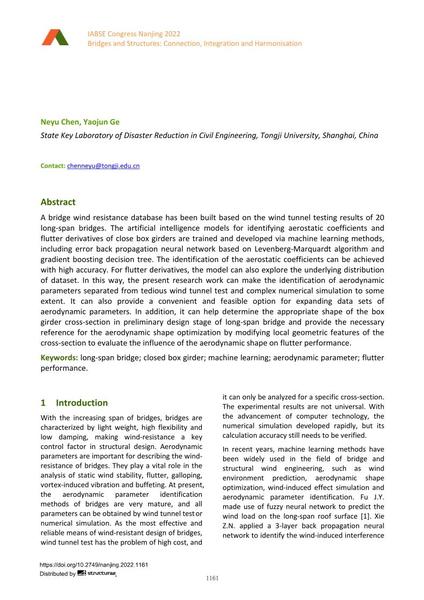Aerodynamic Parameter Identification and Flutter Performance Prediction of Closed Box Girder Based on Machine Learning

|
|
|||||||||||
Bibliographic Details
| Author(s): |
Neyu Chen
(State Key Laboratory of Disaster Reduction in Civil Engineering, Tongji University, Shanghai, China)
Yaojun Ge (State Key Laboratory of Disaster Reduction in Civil Engineering, Tongji University, Shanghai, China) |
||||
|---|---|---|---|---|---|
| Medium: | conference paper | ||||
| Language(s): | English | ||||
| Conference: | IABSE Congress: Bridges and Structures: Connection, Integration and Harmonisation, Nanjing, People's Republic of China, 21-23 September 2022 | ||||
| Published in: | IABSE Congress Nanjing 2022 | ||||
|
|||||
| Page(s): | 1161-1170 | ||||
| Total no. of pages: | 10 | ||||
| DOI: | 10.2749/nanjing.2022.1161 | ||||
| Abstract: |
A bridge wind resistance database has been built based on the wind tunnel testing results of 20 long-span bridges. The artificial intelligence models for identifying aerostatic coefficients and flutter derivatives of close box girders are trained and developed via machine learning methods, including error back propagation neural network based on Levenberg-Marquardt algorithm and gradient boosting decision tree. The identification of the aerostatic coefficients can be achieved with high accuracy. For flutter derivatives, the model can also explore the underlying distribution of dataset. In this way, the present research work can make the identification of aerodynamic parameters separated from tedious wind tunnel test and complex numerical simulation to some extent. It can also provide a convenient and feasible option for expanding data sets of aerodynamic parameters. In addition, it can help determine the appropriate shape of the box girder cross-section in preliminary design stage of long-span bridge and provide the necessary reference for the aerodynamic shape optimization by modifying local geometric features of the cross-section to evaluate the influence of the aerodynamic shape on flutter performance. |
||||
| Keywords: |
machine learning long-span bridge closed box girder aerodynamic parameter flutter performance
|
||||
| Copyright: | © 2022 International Association for Bridge and Structural Engineering (IABSE) | ||||
| License: | This creative work is copyrighted material and may not be used without explicit approval by the author and/or copyright owner. |
||||
